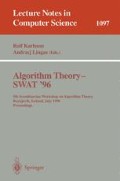Abstract
Ordered binary decision diagrams (OBDDs, for short) represent Boolean functions as directed acyclic graphs. The minimum consistent OBDD problem is, given an incomplete truth table of a function, to find the smallest OBDD that is consistent with the truth table with respect to a fixed order of variables. We show that this problem is NP-hard, and prove that there is a constant ε > 0 such that no polynomial time algorithm can approximate the minimum consistent OBDD within the ratio n ε unless P=NP, where n is the number of variables. This result suggests that OBDDs are unlikely to be polynomial time learnable in PAC-learning model.
Preview
Unable to display preview. Download preview PDF.
References
Angluin, D.: On the complexity of minimum inference of regular sets, Information and Control 39, 337–350, 1978.
Angluin, D.: Learning regular sets from queries and counterexamples, Information and Computation 75, 87–106, 1987.
Angluin, D.: Queries and concept learning, Machine Learning 2, 319–342, 1988.
Angluin, D.: Negative results for equivalence queries, Machine Learning 5, 121–150, 1990.
Blum, A.: New approximation algorithms for graph coloring, Journal of the Association for Computing Machinery 41, 470–516, 1994.
Board, R. and Pitt, L.: On the necessity of Occam algorithms, Theoretical Computer Science 100, 157–184, 1992.
Bolling, B. and Wegener, I.: Improving the variable ordering of OBDDs is NP-complete, Technical Report, Universität Dortmund, 1994.
Bryant, R. E.: Symbolic Boolean manipulation with ordered binary-decision diagrams, ACM Computing Surveys 24, 293–318, 1992.
Ergün, F., Kumar, S. R. and Rubinfeld, R.: On learning bounded-width branching programs, Proc. 8th International Workshop on Computational Learning Theory, 361–368, 1995.
Garey, M. and Johnson, D. S.: Computers and intractability: A guide to the theory of NP-completeness, W. H. Freeman and Company, 1978.
Gavaldà, R. and Guijarro, D.: Learning ordered binary decision diagrams, Proc. 6th International Workshop on Algorithmic Learning Theory, 228–238, LNAI 997, 1995.
Gold, E. M.: Complexity of automaton identification from given data, Information and Control 37, 302–320, 1978.
Hancock, T., Jiang, T., Li, M. and Tromp, J.: Lower bounds on learning decision lists and trees, draft, 1996.
Li, M. and Vazirani, U.: On the learnability of finite automata, Proc. 1988 Workshop on Computational Learning Theory, 359–370, 1988.
Lund, C. and Yannakakis, M.: On the hardness of approximating minimization problems, Proc. 25th Annual ACM Symposium on Theory of Computing, 286–293, 1993.
Pitt, L. and Valiant, L. G.: Computational limitation on learning from examples, Journal of the Association for Computing Machinery 35, 965–984, 1988.
Pitt, L. and Warmuth, M. K.: The minimum consistent DFA problem cannot be approximated within any polynomial, Journal of the Association for Computing Machinery 40, 95–142, 1993.
Sauerhoff, M. and Wegener, I.: On the complexity of minimizing the OBDD size for incompletely specified functions, Technical Report 560, Univ. Dortmund, 1994.
Sieling, D. and Wegener, I.: Reduction of OBDDs in linear time, Information Processing Letter 48, 139–144, 1993.
Takenaga, Y. and Yajima, S.: NP-completeness of minimum binary decision diagram identification, Technical Report of IEICE, COMP92-99, 57–62, 1993.
Valiant, L. G.: A theory of the learnable, Communications of the ACM 27, 1134–1142, 1984.
Author information
Authors and Affiliations
Editor information
Rights and permissions
Copyright information
© 1996 Springer-Verlag Berlin Heidelberg
About this paper
Cite this paper
Hirata, K., Shimozono, S., Shinohara, A. (1996). On the hardness of approximating the minimum consistent OBDD problem. In: Karlsson, R., Lingas, A. (eds) Algorithm Theory — SWAT'96. SWAT 1996. Lecture Notes in Computer Science, vol 1097. Springer, Berlin, Heidelberg. https://doi.org/10.1007/3-540-61422-2_125
Download citation
DOI: https://doi.org/10.1007/3-540-61422-2_125
Published:
Publisher Name: Springer, Berlin, Heidelberg
Print ISBN: 978-3-540-61422-7
Online ISBN: 978-3-540-68529-6
eBook Packages: Springer Book Archive

